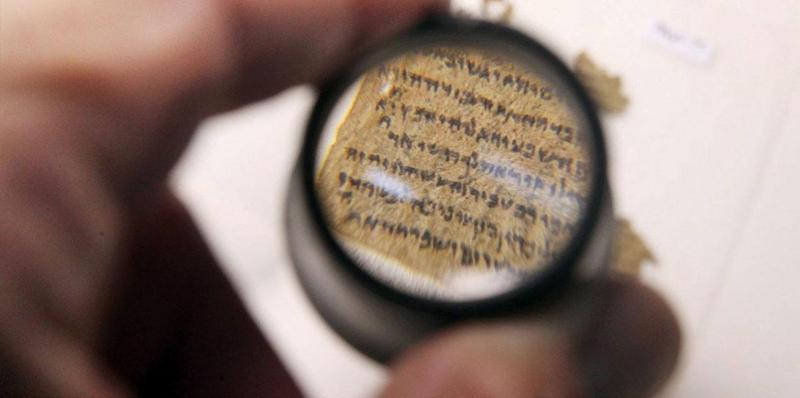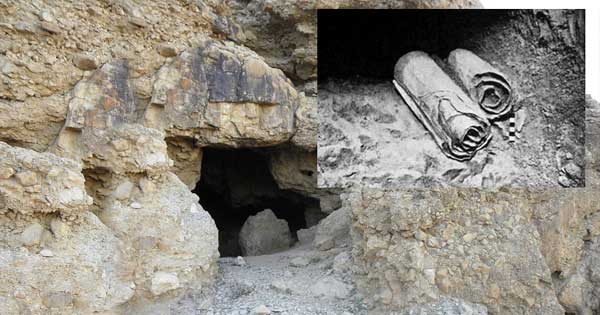New Dead Sea Scrolls Discovered: Archaeologists Excited to Unearth Two New Fragments in the Cave of Skulls
New Dead Sea Scrolls Discovered: Archaeologists Excited to Unearth Two New Fragments in the Cave of Skulls

The Dead Sea Scrolls are a set of nearly 1,000 manuscripts in Hebrew, Aramaic, and ancient Greek, which contain some of the oldest known versions of the Hebrew Bible and are said to be one of the greatest archaeological finds in history.
Now, two more pieces of Dead Sea Scrolls and some textile wrapped around a bundle of beads have been found in the Cave of the Skulls in the Judean Desert near the Dead Sea.
The scroll fragments have yet to be deciphered because the writing on them is so faint, but it is possible that they will add new, previously unknown information about the life of Jesus.

Researchers from Hebrew University and the Israel Antiquities Authority say they still are unsure whether the writing is in Hebrew, Aramaic or a completely different dialect altogether.
The pieces of papyrus are about 2 by 2 cm (0.78 by 0.78 of an inch) and others are fragmentary. Some have writing, some do not have discernible writing, says Haartez in an article about the find.
Archaeologists renewed explorations of the cave in May and June 2016 after Roman and Iron Age documents started being sold on the black market.
“The most important thing that can come out of these fragments is if we can connect them with other documents that were looted from the Judean Desert, and that have no known provenance,” Dr. Uri Davidovich of the Hebrew University of Jerusalem told Haaretz.
Some of the 870 Dead Sea Scrolls found in past years showed clear writing, but others are more difficult to decipher and are still being analyzed. The first of the Dead Sea Scrolls was found in 1947 by a Bedouin shepherd who tossed a rock into a cave near Qumran and heard a jar cracking, Haaretz says. The shepherd went into the cave and found documents that came to be called the Dead Sea Scrolls.
Archaeologist Yohanan Ahranoi discovered the Cave of the Skulls in 1960. It was named for the seven human skulls and other bones in it. It is one of several caves that comprise a large cave complex of natural spaces on a steep cliff alongside the Tze’elim stream in the desert.
Nearby is the Cave of the Arrows where 30-inch arrow shafts plus iron arrowheads about 1,800 years old were located. Extremely dry conditions in the Judean Desert help preserve even organic objects.
Also nearby is the Cave of the Scrolls, where early documents dating to the time of the Bar Kokhba revolt have been unearthed.
People have occupied the caves on and off from prehistoric times until the period when Rome ruled Judea. Many of the finds made during the latest period are fragmentary and may have been from secondary dumps by looters.
Earlier finds in the cave include fragments of textiles, rope, leather items, wooden artifacts and bone tools. Pieces of a wooden lice comb dating to the Bar Kokhba revolt also were found there, Haaretz reports.
Supplementing the organic finds are pottery shards, stone vessels and flint objects. Metal objects included needles and hollow-headed hobnails for use on sandals.
The most recent textile bundle containing beads has not been opened but was x-rayed to ascertain what is inside. This bundle joins two others that Dr. Aharoni found. It is the biggest cache of beads in the Levant from the Chalcolithic period, which predates the Copper Age.
Unfortunately, looters digging in the caves have upset the layers so much it is hard to determine exactly when some artifacts and objects date from.
The findings of remains of thousands of food items, including palm dates, olives, pomegranates and barley and wheat back up professional estimates that the caves’ use by humans dates to the Chalcolithic and by rebelling refugees during the Roman era more than 2,000 years ago.
Uri Davidovich, one of the excavation directors, told Haaretz: “We have all the reasons to believe that there are still scrolls hidden. Several documents from the Roman times and even from the Iron Age have surfaced in recent years in the antiquities market. They must have originated in the Judean Desert caves.”
Be the first to post a message!